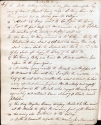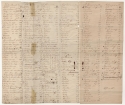Georgetown College was rooted in slavery. It was founded by Maryland’s Catholic elite, whose fortunes came from slave labor. Slaves worked on the Jesuit plantations in Maryland that helped to sustain the Jesuits’ religious and educational mission. The sale of 272 slaves in 1838 rescued the College from crushing debt. Moreover, men and women held in bondage were also part of the day-to-day operation of Georgetown College in its early decades. The school’s ties to slavery help to explain why a majority of Georgetown students and alumni who fought in the Civil War sided with the Confederacy. This display presents some of the archival traces of slavery at the College, from sacramental records to property records to a runaway advertisement for a man named Isaac.
Hire of Sukey, 1792
Slave hiring was a common practice wherever there was a market for slave labor. The College ledgers contain several records of local owners hiring their enslaved workers to the College. Here William Digges hires a woman named Sukey out to the College from 1792 to 1797 for the sum of £10 per year. Source: Georgetown College accounts ledger, 1789-1793, Georgetown University Archives.
Marriage of Philis, 1795
The Catholic Church allowed enslaved people to marry with the permission of their owners. Sacramental registers for Holy Trinity Church contain numerous records of slave marriages, including this record of a marriage that took place in the College chapel between a man named David Thomas and an enslaved woman named Philis, who was owned by Elizabeth Boyle of Georgetown. Source: Trinity Church, Georgetown D.C., Record of Marriages and Baptisms 1795 to 1805.
Bill of Sale for Watt, 1802
In 1802, Charles Boarman sold a thirty-year-old man named Wat to Rev. Leonard Neale, the president of Georgetown College, for $400 “for the use of said College.” Wat was then sold to St. Inigoes, one of the Jesuit plantations in southern Maryland. Source: Bill of sale, Vault Collection, Box 1, Georgetown University Archives.
Runaway Ad for Isaac, 1814
American newspapers from the 18th and 19th centuries are filled with advertisements from owners seeking the return of enslaved people who had run away in search of family and freedom. When Isaac ran away from Georgetown College, Rev. John McElroy, a Jesuit priest affiliated with the college, placed this advertisement seeking his return. Isaac was captured in Baltimore and sold. Source: Daily National Intelligencer, February 1, 1814.
Burial of Billy, 1817
The Jesuit priest Rev. John McElroy kept a daily journal documenting his life at Georgetown. In August 1817, he recorded the death of a man known as Billy the Blacksmith, presumably a slave at the College. Billy was buried at the college burial ground, near what is today Reiss and Arrupe Halls, in a ceremony attended by students. Source: Diary of Rev. John McElroy S.J., Booth Family Center for Special Collections, Georgetown University Library.
Philodemic Society Debate, 1830 or 1831
Georgetown students organized a Philodemic Society in 1830. “Should slaves be liberated?” was the subject of the Society’s 10th debate. Arguing the affirmative were Benjamin Rush Floyd and James Mulledy; John Digges and Samuel Mulledy argued the negative, which won the day. Source: Amanuensis Book September 25, 1830 - July 25, 1837, The Philodemic Society Archives, Georgetown University Archives.
Slave Census, 1838
By the 1830s, the Maryland Province of the Society of Jesus owned nearly three hundred men, women, and children, who lived on several plantations across Maryland. This census of the Jesuit slaves was compiled in preparation for the sale of the slaves to Louisiana in 1838. It shows their names, ages, family relationships, and where they lived. Source: Maryland Province Archives, Oversize Box 4 (WO 112), Booth Family Center for Special Collections, Georgetown University.
Financial Statement, 1841
Proceeds from the mass sale of the Maryland Jesuit slaves helped the College to pay off a burdensome debt. The sale did not end the presence of slaves at the College, though. This financial statement for the College from 1841 indicates the presence of two slaves on campus. Slavery was not abolished in Washington, D.C. until 1862. Source: Maryland Province Archives, Booth Family Center for Special Collections, Georgetown University.
Exhibition curated by Prof. Adam Rothman, Department of History, Georgetown University.
With assistance from:
Scott Taylor, Manuscripts Archivist, Booth Family Center for Special Collections
Ann Galloway, Assistant University Archivist, Booth Family Center for Special Collections
See more about the history of slavery at Georgetown on the Georgetown Slavery Archive website.







